Who is Jade Emperor?
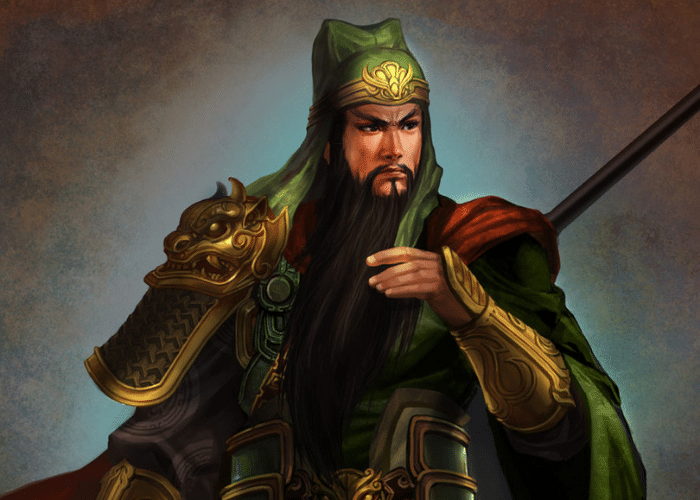

The Jade Emperor (Chinese: 玉皇; pinyin: Yù Huáng or 玉帝, Yù Dì) in Chinese culture, traditional religions and myth is one of the representations of the first god (太帝 tài dì).
The Jade Emperor (Chinese: 玉皇; pinyin: Yù Huáng or 玉帝, Yù Dì) in Chinese culture, traditional religions and myth is one of the representations of the first god (太帝 tài dì). In Daoist theology he is the assistant of Yuanshi Tianzun, who is one of the Three Pure Ones, the three primordial emanations of the Tao. In Vietnamese folk religion, he is called Ngọc Hoàng Thượng đế (or Ông Trời, Heavenly Lord). He is often identified with Śakra in Chinese Buddhist cosmology. In Korean mythology he is known as Haneullim. The Jade Emperor is known by many names, including Heavenly Grandfather (天公, Tiān Gōng), which originally meant “Heavenly Duke”, which is used by commoners; the Jade Lord; the Highest Emperor; Great Emperor of Jade (玉皇上帝, Yu Huang Shangdi or 玉皇大帝, Yu Huang Dadi).
He can also be regarded as a traditional figure among the White Lotus secret society.
It was said that the Jade Emperor was originally the crown prince of the kingdom of Pure Felicity and Majestic Heavenly Lights and Ornaments. At birth, he emitted a wondrous light that filled the entire kingdom. When he was young, he was kind, intelligent and wise. He devoted his entire childhood to helping the needy (the poor and suffering, the deserted and single, the hungry and disabled). Furthermore, he showed respect and benevolence to both men and creatures. After his father died, he ascended the throne. He made sure that everyone in his kingdom found peace and contentment. After that, he told his ministers that he wished to cultivate Tao on the Bright and Fragrant Cliff.
After 1,750 eons, each eon lasting for 129,600 years (3602 years), he attained Golden Immortality. After another one hundred million years of cultivation, he finally became the Jade Emperor (using the given figures, this period before his becoming the Jade Emperor lasted for a total of about 326,800,000 years.)
There are several stories as to how the twelve animals of the Chinese zodiac were chosen. In one, the Jade Emperor, although having ruled Heaven and Earth justly and wisely for many years, had never had the time to actually visit the Earth personally. He grew curious as to what the creatures looked like. Thus, he asked all the animals to visit him in heaven. The Cat, being the most handsome of all animals, asked his friend the Rat to wake him on the day they were to go to Heaven so he wouldn’t oversleep. The Rat, however, was worried that he would seem ugly compared to the Cat, so he didn’t wake the cat. Consequently, the Cat missed the meeting with the Jade Emperor and was replaced by the Pig. The Jade Emperor was delighted with the animals and so decided to divide the years up among-st them. When the cat learned of what had happened, he was furious with the Rat and that, according to the story, is why cats and Rats are enemies to this day.
The Cat however, does have a place in the Vietnamese zodiac, replacing the Rabbit.
The Jade Emperor ordered Mountain God to trap the four dragons. However, from each mountain that trapped a dragon there sprang a new river. From Yellow Dragon came the Yellow River, from Long Dragon the Yangtze River, from Black Dragon the Amur River, and from Pearl Dragon the Pearl River. The rivers thereafter flowed from west to east and north to south, the dragons ensuring that the people of China would never be without water again.
The Jade Emperor was originally the assistant of the Divine Master of the Heavenly Origin, Yuanshi Tianzun. Yuanshi Tianzun is said to be the supreme beginning, the limitless and eternal creator of Heaven and Earth, who picked Yu-huang, or the Jade Emperor, as his personal successor.
The Jade Emperor will eventually be succeeded by the Heavenly Master of the Dawn of Jade of the Golden Door (金闕玉晨天尊). The characters for both are stamped on the front of the arms of his throne.
The Jade Emperor’s Birthday (天公誕) is said to be the ninth day of the first lunar month
Who is the Chinese main god?
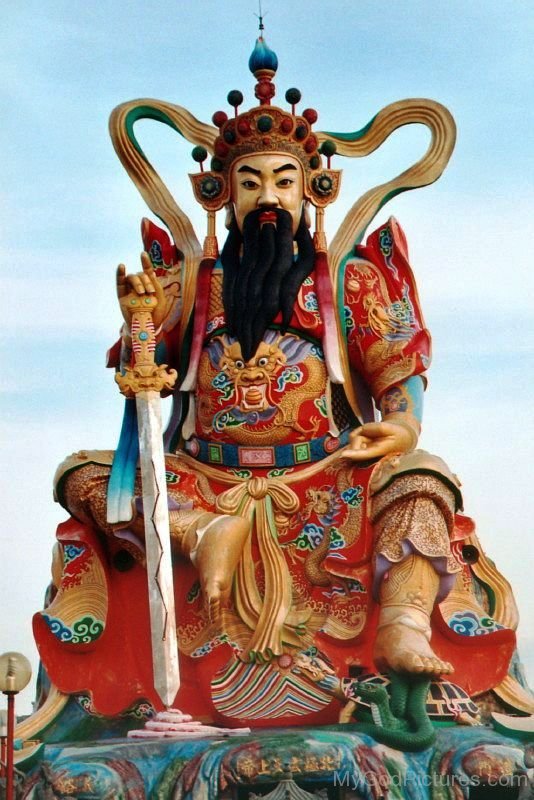
Shangdi, (Chinese: “Lord-on-High”) Wade-Giles romanization Shang-ti, also called Di, ancient Chinese deity, the greatest ancestor and deity who controlled victory in battle, harvest, the fate of the capital, and the weather.
Is Goku the Monkey King?
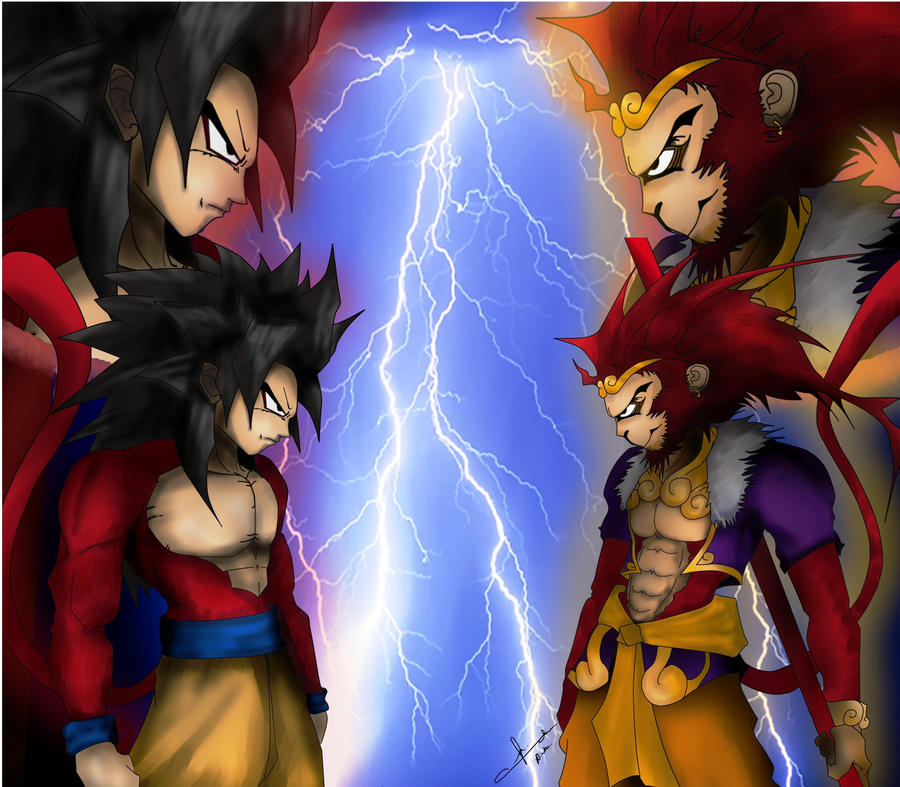
For those who don’t know, Sun Wukong is the legendary Monkey King of Chinese mythology, and the character who Goku is inspired by. “Son Goku” is literally the Japanese pronunciation of “Sun Wukong:. … Sun Wukong is a demigod and one of the most powerful beings that reside on Earth
What is Chinese mythology called?
Chinese mythology (simplified Chinese: 中国神话; traditional Chinese: 中國神話; pinyin: Zhōngguó shénhuà) is mythology that has been passed down in oral form or recorded in literature in the geographic area now known as Greater China. Chinese mythology includes many varied myths from regional and cultural traditions.
What are Chinese mythological creatures?
Baku (mythology), a tapir-like creature that lives by eating people’s dreams. Bashe, a python-like snake that ate elephants. Bixi, a dragon with the shell of a turtle. Black Tortoise, a turtle that represents the cardinal point North and Winter.
What is the most powerful Chinese mythological creature?
The most powerful is the dragon, a wise and benevolent creature who could change shape and control the waters, among-st other things. The dragon was characterized as male, making its natural counterpart the phoenix, which was characterized as female.
What are the 4 mythical creatures?
These four creatures are also referred to by a variety of other names, including “Four Guardians”, “Four Gods”, and “Four Auspicious Beasts”. They are the Azure Dragon of the East, the Vermilion Bird of the South, the White Tiger of the West, and the Black Tortoise (also called “Black Warrior”) of the North.
The mythical beasts of China are exciting because they give access to the boundless realms of power inherent in the imagination. The five mythical creatures represented in this collection are the Taotie, the Dragon, the Phoenix, the Fu Lion-Dog, and the Bixie.
Buddhism originated in India as a belief of rebirth or reincarnation. Being would be reborn in different forms based on the lessons they learned while alive. In order to escape the endless cycle, one must reach Nirvana or enlightenment. Reaching Nirvana is the ultimate goal of a Buddhist.
Buddhism is believed to be responsible for bringing the concept of hell to Taoism. Hell is a place where individuals must complete tasks to repay for the sins committed during their lifetime.
List of Gods
- Heng o Goddess of the moon.

Heng O was married to the heavenly archer Shen Yi. Shen Yi was never going to die, because he had a magic drink of immortality. She wanted to live forever, like her husband, so she tried to steal the magic drink from Shen Yi. She took the potion and ran away with it, drinking as quickly as she could.
But Shen Yi still chased Heng O down and caught her before she could drink all of the magic drink. She had not drunk all of the magic drink, so she could not go all the way up to heaven with the other gods. But she had drunk enough of it to get to the moon. So there she sits forever on the moon.
- Cheng Huang God of walls and ditches.
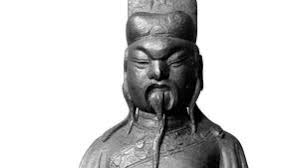
Traditionally, the City God, usually called Cheng Huang Ye (Lord of the Wall and Moat), played a key role in the so-called “otherworldly bureaucracy” of Chinese religion. He was considered responsible for the safety and prosperity of his territory in the same way as was a county magistrate.
- Chih Nii Goddess of spinners, weavers, and clouds.
The daughter of Shang-ti, Chih-Nii is the goddess of spinners and weavers. She makes clothes for all the gods of heaven, a task that keeps her so busy that she has had no time to find a husband. Fortunately for Chih-Nii, however, her sister convinced her to take a rest and go to earth.
While the women were bathing in a stream, a cowherd came along and hid Chih-Nii’s clothes. When he would not return them, Chih-Nii was forced to remain on earth and eventually fell in love with the mischievous cowherd. Unfortunately, the gods soon recalled Chih-Nii. Recovering Chih-Nii’s clothes from their hiding place, the cowherd tried to follow her to heaven, but Shang-ti stopped the mortal on the far side of the Celestial River (the Milky Way). Chih-Nii may now cross the Celestial river to visit her lover only on the seventh day of the seventh month each year, when the magpies gather to make a bridge with their wings.
- Chin Shu Pao Guardian God.
- Chu Jung God of fire and executions.
Chu Jung In Chinese legend, a deified mortal, nicknamed Ch’ih Ti (the red emperor), honored as the god of fire, which he taught men how to use. He is also regarded as the spirit of the Southern Sea. He helped break the link between heaven and earth and was appointed to keep men in their right positions in the established order. He is sometimes portrayed seated on or riding a tiger, or as an animal with a three-eyed human face, the extra eye in the center of his forehead. He is surrounded by his servants and fire symbols, a fiery serpent and a fire wheel—plus a pen and pad to list the places he intends to burn. He is invoked both to prevent and to cause fire.
- Erh Lang Shape shape shifter against evil

Erlang Shen (二郎神) or Erlang, also known as the Lord of Sichuan (川主), is a Chinese god with a third truth-seeing eye in the middle of his forehead.
Erlang Shen may be a deified version of several semi-mythical folk heroes who helped regulate China’s torrential floods dating variously from the Qin, Sui, and Jin dynasties. A later Buddhist source identifies him as the second son of the Northern Heavenly King Vaishravana.
In the Ming semi-mythical novels Creation of the Gods and Journey to the West, Erlang Shen is the nephew of the Jade Emperor. In the former, he assists the Zhou army in defeating the Shang. In the latter, he is the second son of a mortal and the Jade Emperor’s sister Yaoji. In the legend, he is known as the greatest warrior god of heaven.
- Feng Po Po Goddess of winds

Feng Po Po, also called Feng Popo or Feng Pho Pho (Chinese: 风婆婆), is the goddess of the wind in Chinese mythology who rules over storms and moisture.She is referred to as “Madame Wind”, and is usually depicted as a crone, old and wrinkled. Feng Po Po can be seen riding through clouds on the back of a tiger which represents courage and bravery signifying her importance in the Chinese mythology.The tiger the goddess rides on is also a symbol of the autumnal season and therefore associated with the Crone stage of life which further ties the tiger to the goddess.
Feng Po Po is usually portrayed as replacing Feng Bo, the male form of Fei Lian. It is unclear whether she replaces Fei Lian, or becomes his new human form. In some later traditions, myths such as Leizi’s marriage to the Thunder God, Feng Po Po directly replaces Feng Bo and is the one who was moving everyone.Feng Po Po carries a full sack of wind in her arms when she is riding on the back of a tiger. On calm days she expresses her generous spirit by stuffing all the winds into her sack, but when her mood turns foul or the sack of wind becomes too heavy, she unleashes pent up winds in the form of violent storms.
- Fu Hsi God of happiness.

Fuxi or Fu Hsi (伏羲 ~ 伏犧 ~ 伏戲) is a culture hero in Chinese legend and mythology, credited along with his sister and wife Nüwa with creating humanity and the invention of music, hunting, fishing, domestication, and cooking as well as the Cangjie system of writing Chinese characters around 2,000 BC. Fuxi was counted as the first of the Three Sovereigns at the beginning of the Chinese dynastic period.
Pangu was said to be the creation god in Chinese mythology. He was a giant sleeping within an egg of chaos. As he awoke, he stood up and divided the sky and the earth. Pangu then died after standing up, and his body turned into rivers, mountains, plants, animals, and everything else in the world, among which is a powerful being known as Huaxu (華胥). Huaxu gave birth to a twin brother and sister, Fuxi and Nüwa. Fuxi and Nüwa are said to be creatures that have faces of human and bodies of snakes.
Fuxi was known as the “original human”, and he was said to have been born in the lower-middle reaches of the Yellow River in a place called Chengji (成紀) (possibly modern Lantian, Shaanxi province, or Tianshui, Gansu province).
A possible historical interpretation of the myth is that Huaxu (Fuxi’s mother) was a leader during the matriarchal society (c. 2,600 BC) as early Chinese developed language skill while Fuxi and Nüwa were leaders in the early patriarchal society (c. 2,600 BC) while Chinese began the marriage rituals.Fuxi is said to have lived for 197 years altogether and died at a place called Chen (modern Huaiyang, Henan), where a monument to him can still be found and visited as a tourist attraction.
- Hou Chi God of Harvest
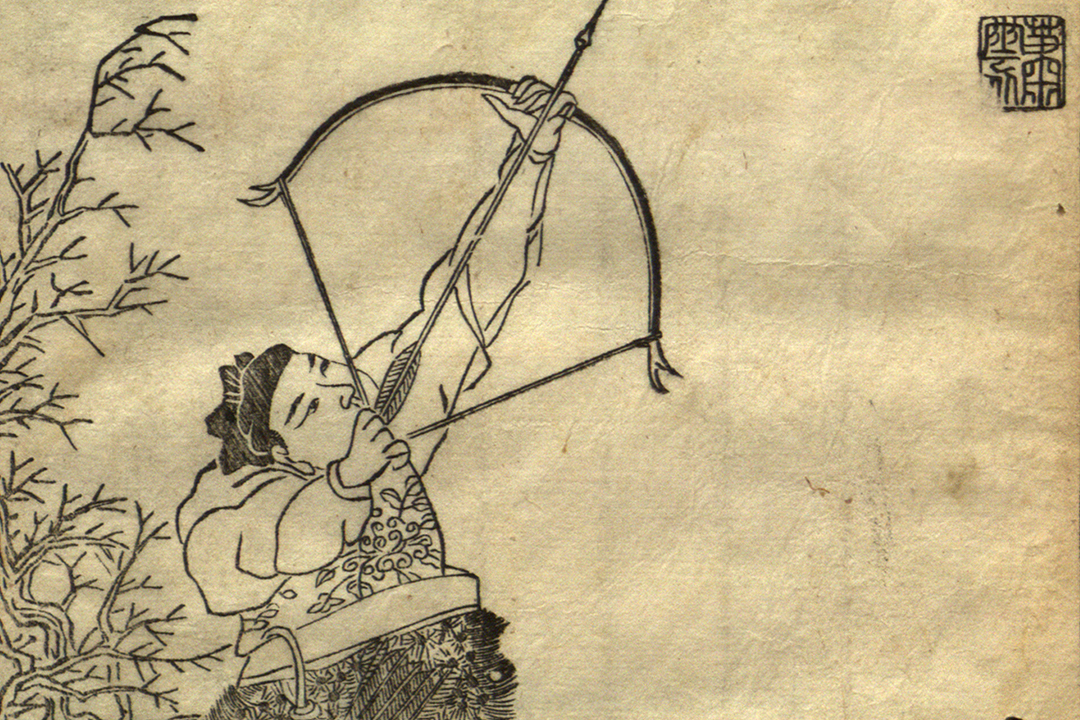
Hou Ji, Wade-Giles romanization Hou Chi, in Chinese mythology, Lord of Millet Grains, who was worshipped for the abundant harvests that he graciously provided for his people. The Chinese honoured him not only for past favours but in the hope that devotion to the deity would guarantee continued blessings. An old tradition explained that Hou Ji was miraculously conceived when his childless mother stepped on the toeprint of a god. The child, reared in a forest by birds and animals, served as minister of agriculture in prehistoric times. Sacrifices in his honour were offered by rulers of the Xia dynasty (22nd–19th/18th century BCE) and of the later Zhou dynasty (600–255 BCE), which claimed him as their ancestor.
- Hsi Wang Mu The high Goddess.

The Queen Mother of the West, known by various local names, is a mother goddess in Chinese religion and mythology, also worshiped in neighboring Asian countries, and attested from ancient times. From her name alone some of her most important characteristics are revealed: she is royal, female, and is associated with the west.
The first historical information on her can be traced back to oracle bone inscriptions of the 15th century BCE that record sacrifices to a “Western Mother”.Even though these inscriptions illustrate that she predates organized Taoism, she is most often associated with Taoism. The growing popularity of the Queen Mother of the West, as well as the beliefs that she was the dispenser of prosperity, longevity, and eternal bliss took place during Han dynasty, in the 2nd century BCE, when the northern and western parts of China were able to be better known because of the opening of the Silk Road.
Queen Mother of the West is a calque of Xiwangmu in Chinese sources, Seiōbo in Japan, Seowangmo in Korea, and Tây Vương Mẫu in Vietnam. She has numerous titles, one being Yaochi Jinmu (瑤池金母), the “Golden Mother of the Jade Pond”(also translated “Turquoise Pond”). She is also known in contemporary sources as the Lady Queen Mother.
In the Maternist current of Chinese salvationist religions she is the main deity and is called upon as the Wusheng Laomu (Chinese: 無生老母; lit. ‘unborn old mother’), also called Wujimu (無極母; lit. ’infinite mother’). With this title, Xiwangmu represents the absolute principle of reality, or the creative origin of all things.
Tang writers called her “Golden Mother the First Ruler”, the “Golden Mother of Tortoise Mountain”, “She of the Nine Numina and the Grand Marvel”, and the “Perfected Marvel of the Western Florescence and Ultimate Worthy of the Cavernous Darkness”. Commoners and poets of the era referred to her more simply as the “Queen Mother”, the “Divine Mother”, or simply “Nanny” (Amah).
- Hsuan Tien Shang Ti God of Water.

Xuanwu (玄武) or Xuandi (Chinese: 玄帝; pinyin: Xuándì), also known as Zhenwu (真武 “True Warrior” or “Truly Valiant”) or Zhenwudadi (真武大帝 “True Martial Great Emperor” or “Truly Valiant Great Emperor”), is a powerful deity in Chinese religion, one of the higher-ranking deities in Taoism. He is revered as a powerful god, able to control the elements and capable of great magic. He is identified as the god of the north Heidi (黑帝 “Black Emperor”) and is particularly revered by martial artists. He is the patron god of Hebei, Henan, Manchuria and Mongolia. As some Han Chinese (now the modern-day Cantonese and Fujianese peoples) migrated into the south from Hebei and Henan during the Tang-Song era, Xuanwu is also widely revered in the Guangdong, Guangxi and Fujian provinces, as well as among the overseas diaspora.
Since the usurping Yongle Emperor of the Ming dynasty claimed to receive the divine assistance of Xuanwu during his successful Jingnan Campaign against his nephew, he had a number of Taoist monasteries constructed in the Wudang Mountains of Hubei, where Xuanwu allegedly attained immortality.
- Hu Tu Goddess of Earth.
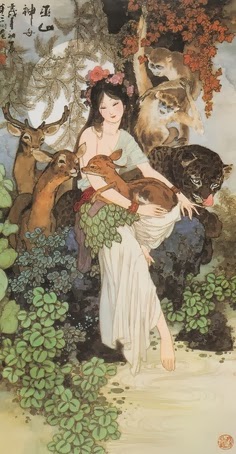
Hòutǔ (Chinese: 后土; lit. ‘Queen of the Earth’) or Hòutǔshén (后土神; ‘Goddess Queen of the Earth’), also Hòutǔ Niángniáng (in Chinese either 厚土娘娘; ‘Deep Earth Lady’ or 后土娘娘; ‘Earth Queen Lady’), otherwise called Dimǔ (地母; ‘Mother Earth’) or Dimǔ Niángniáng (地母娘娘; ‘Lady Mother Earth’), is the deity of deep earth and soil in Chinese religion and mythology. Houtu is the overlord of all the Tu Di Gong (“Lord of Local Land”) world wide.Houtu was first worshipped by Emperor Wen of Han (in Fenyin County, modern-day Wanrong County, Shanxi).Houtu was worshiped by Emperor Wu of Han in 113 BC
- I Ti God of wine.
- Kuan Ti God of war.
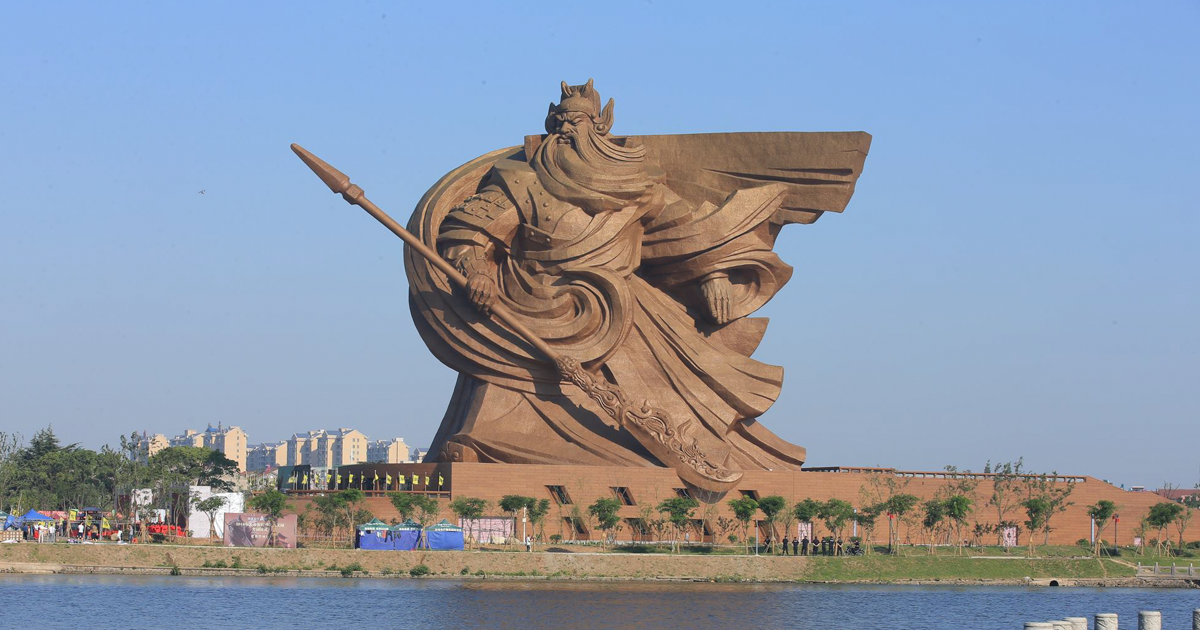
Kuan Ti is the red-faced God of War, which is worshipped in many Chinese home. Kuan Ti is also known as Guan Yu or Guan Gong.. The portrait or statue of Kuan Ti always faces the front door of homes to prevent demons and evil spirits from entering. Kuan Ti is a powerful God in the pantheon.Kuan Ti was an important figure in the civil war that followed the collapse of the Han Dynasty. He was part of the group that was still loyal to the Han and was seeking to restore the Emperor to power. Kuan Ti was executed when he was ambushed and captured while attempting a retreat.
- Kuan Yin The Great Mother.
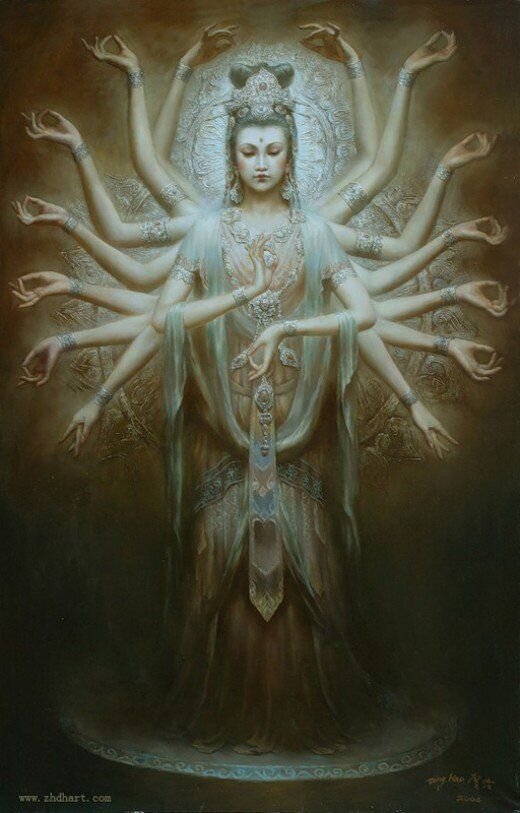
Kuan-Yin is seen by the humble as the Great Mother Goddess, who is their friend, benefactor and protector, while philosophers tend to see her as the divine force of compassion, spreading harmony throughout the universe.
- Kuei Hsing God of tests, exams, literature, and students.
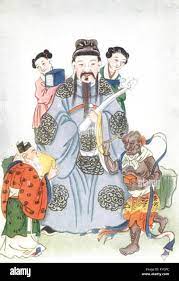
Kuei Xing, K’uei Hsing, in Chinese religion, a brilliant but ugly dwarf who, as the god of examinations, became the deity of scholars who took imperial examinations.
Kuei Xing, whose name before deification was Zhong Kuei, is said to have passed his own examination with remarkable success but was denied the usual honours when the emperor beheld his ugly features. Brokenhearted, Kuei attempted suicide. He would have died, according to one account, had not an ao fish (or an ao turtle) borne him to safety. Another account says that Kuei actually died.
As depicted in art, Kuei bends forward like a runner, his left leg raised behind, the other sometimes balanced on the head of a fish (or giant sea turtle). Sometimes he sits astride the animal. In his right hand Kuei holds a writing brush to check off the most outstanding scholar candidates whose names are listed on a paper belonging to Yudi, the great Jade Emperor. In his left hand Kuei holds an official seal (some say a bushel basket to measure the talents of examinees).
Before the imperial examinations were discontinued in 1905, virtually every Chinese scholar gave Kuei a place of honour in his home, with images and name tablets. Some delightful representations of the god merely stylized the Chinese character of his name (kuei) in such a way that a man in motion was clearly visible. The arms are extended, the left leg is raised behind, and the right foot is sometimes balanced on the Chinese character for ao (sea turtle).
Kuei Xing resides among the stars as the deity in charge of the Ursa Major constellation. He is also one of two assistants assigned to help Wendi, the god of literature.
- Lau Tien Yeh The Jade Emperor.

Lei Kung, also called Lei Shen (“Thunder God”), Chinese Daoist deity who, when so ordered by heaven, punishes both earthly mortals guilty of secret crimes and evil spirits who have used their knowledge of Daoism to harm human beings. Lei Gong carries a drum and mallet to produce thunder and a chisel to punish evildoers.Lei Gong is depicted as a fearsome creature with claws, bat wings, and a blue body and wears only a loincloth. Temples dedicated to him are rare, but some persons do him special honour in the hope that he will take revenge on their personal enemies.Lei Gong’s specialty is thunder, but he has assistants capable of producing other types of heavenly phenomena. Dian Mu (“Mother of Lightning”), for example, uses flashing mirrors to send bolts of lightning across the sky. Yun Tong (“Cloud Youth”) whips up clouds, and Yuzi (“Rain Master”) causes downpours by dipping his sword into a pot. Roaring winds rush forth from a type of goatskin bag manipulated by Feng Bo (“Earl of Wind”), who was later replaced by Feng Popo (“Madame Wind”). She rides a tiger among the clouds
- Lo Shen Goddess of rivers.
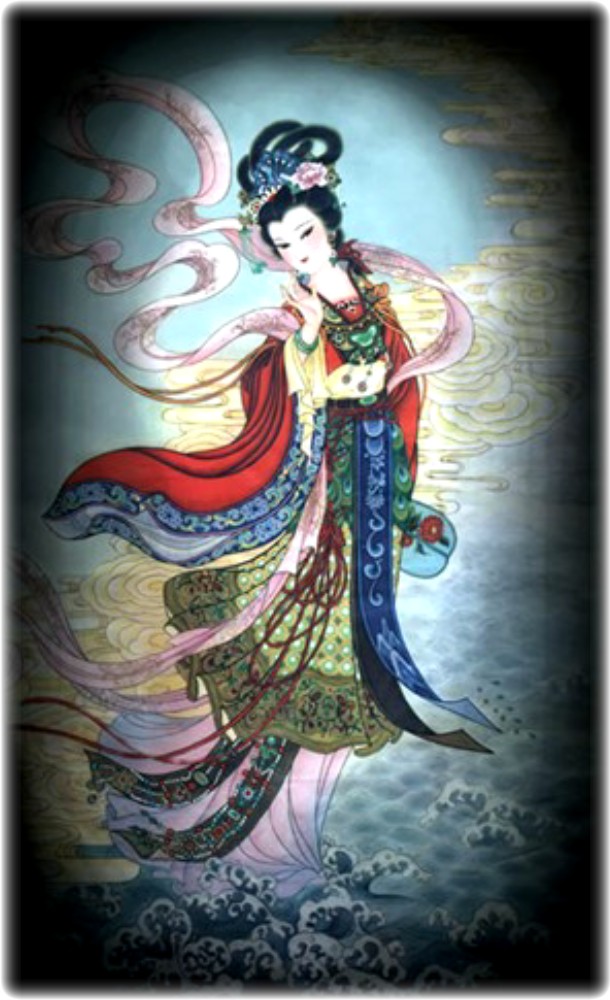
Luo Shen 洛神, the “Goddess of the River Luo” is a deity in ancient China. She is also called Consort Mi 宓妃, as Cao Zhi’s 曹植 rhapsody Luoshenfu 洛神賦 states. Li Shan 李善 comments that she was the daughter of the mythical emperor Mi Xi 宓羲 (i.e. Fu Xi 伏羲). She had drowned when she crossed the river and was then transformed into a river deity. The name Consort Mi is already mentioned in the elegy Li Sao 離騷 by Qu Yuan 屈原. In the elegy Tianwen 天問 she is also called Luo Pin 雒嬪 “Lady of the River Luo” and is said to have been the wife of the Earl of the Yellow River 河伯. In Cao Zhi’s rhapsody she is described as being of an utmost beauty and tenderness. There is also a Peking opera with the title of Luoshen 洛神.
- Lu Hsing God of income and employment.
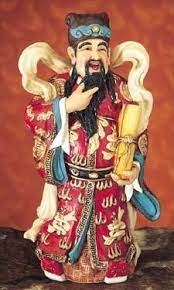
Lu Hsing, in Chinese mythology, one of three stellar gods known collectively as Fulushou. He was honoured as a deity who could make people happy through increased salaries or promotions that brought prosperity (lu).
In life, Luxing was a scholar who bore the name Shi Fen. In the 2nd century BC he was a favourite of Emperor Jing and was made a high official at the royal court. His family prospered through imperial generosity. Perhaps because the Chinese have many gods of wealth and happiness, Luxing is not nearly so widely honoured as is Shouxing, the god of longevity.
- Lu Pan God of carpenters and masons.

Lu Ban (c. 507–444 BC) was a Chinese structural engineer, inventor, and carpenter during the Zhou Dynasty. He is revered as the ChineseDeity (Patron) of builders and contractors.Lu Ban was born in the state of Lu; a few sources claim he was born further to the west, in Dunhuang,to a family of carpenters or artisans during the Spring and Autumn period of the Zhou dynasty. His original name was Gongshu Yizhi. He was also referred to as Gongshu Ban or Pan. He was supposed to have been an indifferent pupil until his love of learning was kindled by the scholar Zi Xia. He later learned woodworking from Bao Laodong. The great demand for his work supposedly compelled him to invent or improve several carpenter’s tools—the saw, the square, the planer, the drill, the shovel, and an ink marking tool—to complete his many projects more quickly.His wife was also credited with inventing the umbrella in order to permit him to work in inclement weather.
According to tradition, he was responsible for several inventions:
- Cloud ladder—a mobile, counterweighted siege ladder.
- Grappling hooks and ram—implements for naval warfare.
- Wooden bird—a non-powered, flying, wooden bird which could stay in the air for three days. It has been suggested to be a prototype of a kite.
- The saw. Legend has it that when Lu Ban was grabbing hold of tree trunks in order to climb a steep slope while gathering firewood, his hand was cut by a leaf with spiny texture. He then realized that he could turn the leaf’s texture into a more efficient tool for tree-cutting, namely the saw.
- Ma Ku Goddess of springtime.

- Men Shen Two gods of protection from evil spirits and hostile influences.
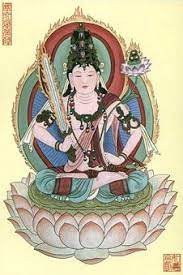
Men Shen, (Chinese: “Door Gods” or “Door Spirits”) Men-shen, also spelled Menshen, in Chinese religion, the two door gods whose separate martial images are posted on respective halves of the double front door of private homes to guarantee protection from evil spirits (guei). One tradition reports that two Tang-dynasty generals stood guard at the imperial gates during a serious illness of Tai Zong (reigned 626–649), who was grievously troubled by evil spirits. Their presence was so effective that the emperor ordered their pictures to be posted permanently on the gates—with salutary effects. At a later date another Men Shen was added and given custody of the rear door. The custom of having Men Shen standing guard at one’s door quickly spread throughout China. During the New Year celebration, the images are refurbished in brilliant colours.
- Meng Po Niang Niang Goddess of past-lives.
Meng Po, often known simply as Lady Meng (‘Dream’), is the Buddhist Goddess who dishes out the Bittersweet Broth of Oblivion. This is a mystic brew made from herbs and pond water which she prepares for the souls of the dead.Meng Po (Chinese: 孟婆; pinyin: Mèng Pó; lit. ‘Old Lady Meng’) is the goddess of forgetfulness in Chinese mythology, who serves soup on the Bridge of Forgetfulness or Nai He Bridge (奈何桥). This soup wipes the memory of the person so they can reincarnate into the next life without the burdens of the previous life. She awaits the dead souls at the entrance of the 9th round (Fengdu).
- Pa Goddess of droughts.
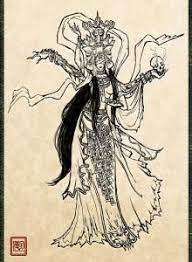
- Pi Hsia Yuan Chin Goddess of childbirth and labor.
- Sao Tsing Niang Goddess of the clouds
Buddhism
- Laughing Buddha

Budai (Chinese: 布袋; pinyin: Bùdài; Korean: 포대, romanized: Podae; Japanese: 布袋, romanized: Hotei) was a semi-historical Chinese monk who is often identified with and venerated as Maitreya Buddha in Chan Buddhism. With the spread of Chan Buddhism, he also came to be venerated in Vietnam, Korea, and Japan.He is said to have lived around the 10th century in the Wuyue kingdom. His name literally means “cloth sack”, and refers to the bag that he is conventionally depicted as carrying as he wanders aimlessly. His jolly nature, humorous personality, and eccentric lifestyle distinguish him from most Buddhist masters or figures. He is almost always shown smiling or laughing, hence his nickname in Chinese, the “Laughing Buddha“. As he is traditionally depicted as overweight, he is also referred to as the “Fat Buddha“, especially in the Western world.Budai has origins centered around cult worship and local legend.He is traditionally depicted as a fat, bald monk wearing a simple robe. He carries his few possessions in a cloth sack, being poor but content.He would excitingly entertain the adoring children that followed him and was known for patting his large belly happily. His figure appears throughout Chinese culture as a representation of both contentment and abundance. Budai attracted the townspeople around him as he was able to predict people’s fortunes and even weather patterns.The wandering monk was often inclined to sleep anywhere he came to, even outside, for his mystical powers could ward off the bitter colds of snow and his body was left unaffected. A recovered death note dated to 916 or 917 A.D., which the monk himself wrote, claims that he is an incarnation of Maitreya, the Buddha of the Future.A body allegedly belonging to Budai was embalmed and displayed at the eastern section of the Great Hall at Yuelin Temple in Fenghua District, Zhejiang.
- Dizang
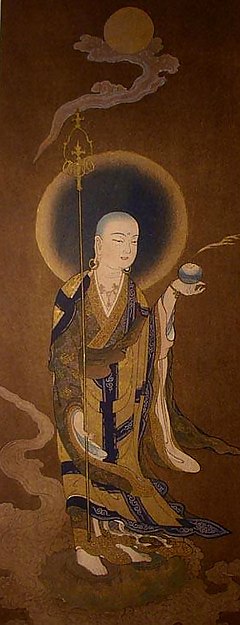
Dizang, Ti-ts’ang, in Chinese Buddhism, bodhisattva (buddha-to-be) who is especially committed to delivering the dead from the torments of hell. His name is a translation of the Sanskrit Kshitigarbha (“Womb of the Earth”). Dizang seeks to deliver the souls of the dead from the punishments inflicted by the 10 judges, or kings, of hell (the fifth, Yanlo Wang, is the Chinese manifestation of the Indian lord of death, Yama). The judges are always represented standing when in the presence of Dizang, as a mark of their deference to him.
His previous lives included an existence as a Brahman maiden who secured the release of her impious mother from hell by devoted prayers to the Buddha. Legends concerning Dizang, emphasizing the virtue of filial piety, are recounted in the Chinese scripture Dizang benyuanjing (“Scripture on Dizang’s Vows”). The mountain Jiuhua in Anhui province is sacred to Dizang and is a favourite place of pilgrimage for Chinese Buddhists. In Japan, Dizang is known as Jizō.
Kṣitigarbha (Sanskrit: क्षितिगर्भ, Chinese: 地藏; pinyin: Dìzàng; Japanese: 地蔵; rōmaji: Jizō; Korean: 지장(地藏); romaja: Jijang; Vietnamese: Địa Tạng, Standard Tibetan: ས་ཡི་སྙིང་པོ་ Wylie: sa yi snying po) is a bodhisattva primarily revered in East Asian Buddhism and usually depicted as a Buddhist monk. His name may be translated as “Earth Treasury”, “Earth Store”, “Earth Matrix”, or “Earth Womb”. Kṣitigarbha is known for his vow to take responsibility for the instruction of all beings in the six worlds between the death of Gautama Buddha and the rise of Maitreya, as well as his vow not to achieve Buddhahood until all hells are emptied. He is therefore often regarded as the bodhisattva of hell-beings, as well as the guardian of children and patron deity of deceased children and aborted fetuses in Japanese culture, where he is known as Jizō (地蔵) or Ojizō-sama (お地蔵様).
Usually depicted as a monk with a halo around his shaved head, he carries a staff to force open the gates of hell and a wish-fulfilling jewel to light up the darkness.
- The Four Heavenly Kings
The Four Heavenly Kings are four Buddhist gods, each of whom is believed to watch over one cardinal direction of the world. In Chinese mythology, they are known collectively as the “Fēng Tiáo Yǔ Shùn” (simplified Chinese: 风调雨顺; traditional Chinese: 風調雨順; lit. ‘Good climate’) or “Sìdà Tiānwáng” (Chinese: 四大天王; lit. ‘Four Great Heavenly Kings’). In the ancient language Sanskrit, they are called the “Chaturmahārāja” (चतुर्महाराज) or “Chaturmahārājikādeva”: “Four Great Heavenly Kings”. The Hall of Four Heavenly Kings is a standard component of Chinese Buddhist temples.
They are collectively named as follows:
| Language | Written form | Romanization | Translation |
|---|---|---|---|
| Sanskrit | चतुर्महाराज | caturmahārāja | Four Kings |
| Lokapāla | guardian of the world | ||
| Chinese | 天王 | Tiānwáng | Heavenly kings |
| 四天王 | Sì Tiānwáng | Four heavenly kings | |
| Korean | 천왕 | Cheonwang | Heavenly kings |
| 사천왕 | Sacheonwang | Four heavenly kings | |
| Japanese | 四天王 | Shitennō | Four heavenly kings |
| Vietnamese | 四天王 | Tứ Thiên Vương | Four heavenly kings |
| Tibetan | rgyal chen bzhi | Four great kings | |
| Thai | จาตุมหาราชา | chatumaharaja | Four great kings |
| จาตุโลกบาล | chatulokkaban | guardian of the world |
All four Kings serve Śakra, the lord of the devas of Trāyastriṃśa. On the 8th, 14th and 15th days of each lunar month, the Kings either send out emissaries or go themselves to inspect the state of virtue and morality in the world of men. Then they report their findings to the assembly of the Trāyastriṃśa devas.
On the orders of Śakra, the Kings and their retinues stand guard to protect Trāyastriṃśa from another attack by the Asuras, which once threatened to destroy the realm of the devas. They also vowed to protect the Buddha, the Dharma, and the Buddha’s followers from danger. In Chinese Buddhism, all four of the heavenly kings are regarded as four of the Twenty Devas (二十諸天 Èrshí Zhūtiān) or the Twenty-Four Devas (二十四諸天 Èrshísì zhūtiān), a group of Buddhist dharmapalas who manifest to protect the Dharma.Statues of the Four Heavenly Kings. From left to right: Vaiśravaṇa, Virūḍhaka, Dhṛtarāṣṭra, and Virūpākṣa in Beihai Park in Beijing, China.
- Statues of the Four Heavenly Kings of Lingyin Temple, Hangzhou, Zhejiang, China.

- Gautama Buddha
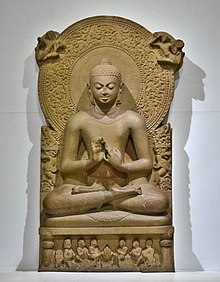
| Personal | |
|---|---|
| Born | Siddhartha Gautama c. 563 BCE or 480 BCE Lumbini, Shakya Republic (according to Buddhist tradition) |
| Died | c. 483 BCE or 400 BCE (aged 80) Kushinagar, Malla Republic (according to Buddhist tradition) |
| Cause of death | Pig-bel disease |
| Resting place | Cremated |
| Religion | Buddhism |
| Spouse | Yashodhara |
| Children | Rāhula |
| Parents | Śuddhodana (father)Maya Devi (mother) |
| Known for | Founder of Buddhism |
| Other names | Shakyamuni (“Sage of the Shakyas”) |
| Senior posting | |
| Predecessor | Kassapa Buddha |
| Successor | Maitreya |
| Sanskrit name | |
| Sanskrit | Siddhārtha Gautama |
| Pali name | |
| Pali | Siddhattha Gotama |

Gautama Buddha, popularly known as the Buddha (also known as Siddhattha Gotama or Siddhārtha Gautama or Shakyamuni), was an ascetic, a religious leader and teacher who lived in ancient India (c. 6th to 5th century BCE or c. 5th to 4th century BCE).He is regarded as the founder of the world religion of Buddhism, and revered by Buddhists as an enlightened being,who rediscovered an ancient path to freedom from ignorance, craving and the cycle of rebirth and suffering. He taught for around 45 years and built a large following, both monastic and lay. His teaching is based on his insight into the arising of suffering or dissatisfaction and its ending—the state called Nirvana (lit. vanishing or extinguishing).
The Buddha was born into an aristocratic family in the Shakya clan, but eventually renounced lay life. According to Buddhist tradition, after several years of mendicancy, meditation, and asceticism, he awakened to understand the workings of the cycle of rebirth and how it can be escaped. The Buddha then traveled throughout the Gangetic plain teaching and building a religious community. The Buddha taught a middle way between sensual indulgence and the severe asceticism found in the Indian śramaṇa movement. He taught a training of the mind that included ethical training, self-restraint, and meditative practices such as jhana and mindfulness. The Buddha also critiqued the practices of Brahmin priests, such as animal sacrifice and the caste system.
A couple of centuries after his death he came to be known by the title Buddha, which means “Awakened One” or “Enlightened One”. Gautama’s teachings were compiled by the Buddhist community in the Vinaya, his codes for monastic practice, and the Suttas, texts based on his discourses. These were passed down in Middle Indo-Aryan dialects through an oral tradition.Later generations composed additional texts, such as systematic treatises known as Abhidharma, biographies of the Buddha, collections of stories about the Buddha’s past lives known as Jataka tales, and additional discourses, i.e. the Mahayana sutras. Due to his influence on Indian religions, in Vaishnavism he came to be regarded as the 9th avatar of Vishnu.
- Guanyin

Guanyin, Guan Yin or Kuan Yin (/ˌɡwɑːnˈjɪn/) (traditional Chinese: 觀音; simplified Chinese: 观音; pinyin: Guānyīn) is the Buddhist bodhisattva associated with compassion. She is the East Asian equivalent of Avalokiteśvara, and has been adopted by other Eastern religions including Chinese folk religion.She was first given the appellation of “goddess of mercy” or the mercy goddess by Jesuit missionaries in China. The Chinese name Guanyin is short for Guanshiyin, which means “[The One Who] Perceives the Sounds of the World.” On the 19th day of the sixth lunar month, Guan Shi Yin’s attainment of Buddhahood is celebrated.
Some Buddhists believe that when one of their adherents departs from this world, they are placed by Guanyin in the heart of a lotus, and then sent to the western pure land of Sukhāvatī. Guanyin is often referred to as the “most widely beloved Buddhist Divinity” with miraculous powers to assist all those who pray to her, as is said in the Lotus Sutra and Kāraṇḍavyūha Sūtra.
Several large temples in East Asia are dedicated to Guanyin including Mount Putuo, Shaolin Monastery, Longxing Temple, Puning Temple, Nanhai Guanyin Temple, Dharma Drum Mountain, Kwan Im Thong Hood Cho Temple, Shitennō-ji, Sensō-ji, Kiyomizu-dera, Sanjūsangen-dō, and many others. Guanyin’s abode and bodhimaṇḍa in India is recorded as being on Mount Potalaka. With the localization of the belief in Guanyin, each area adopted their own Potalaka. In China, Mount Putuo is considered the bodhimaṇḍa of Guanyin. Naksansa is considered to be the Potalaka of Guanyin in Korea. Japan’s Potalaka is located at Fudarakusan-ji. Tibet’s Potalaka is the Potala Palace.
There are several pilgrimage centers for Guanyin in East Asia. Putuoshan is the main pilgrimage site in China. There is a 33 temple Guanyin pilgrimage in Korea which includes Naksansa. In Japan, there are several pilgrimages associated with Guanyin. The oldest one of them is the Saigoku Kannon Pilgrimage, a pilgrimage through 33 temples with Guanyin shrines. Guanyin is beloved by all Buddhist traditions in a nondenominational way and found in most Tibetan temples under the name Chenrézik . Guanyin is also beloved and worshipped in the temples in Nepal. The Hiranya Varna Mahavihar located in Patan is one example. Guanyin is also found in some influential Theravada temples such as Gangaramaya Temple, Kelaniya and Natha Devale nearby Temple of the Tooth in Sri Lanka; Guanyin can also be found in Thailand’s Temple of the Emerald Buddha, Wat Huay Pla Kang (where the huge statue of her is often mistakenly called the “Big Buddha”) and Burma’s Shwedagon Pagoda. Statues of Guanyin are a widely depicted subject of Asian art and found in the Asian art sections of most museums in the world.
| Element | Notes |
|---|---|
| CLOTHING | |
| White robes | Influenced by tantric sutras and mandalas such as the Mandala of the Two Realms which frequently depict Guanyin as being clad in white. |
| Robes sometimes loose or open at chest | Recalling Guanyin’s androgynous origins as a male bodhisattva and her ability to change forms. If drawn androgynously, the breasts may, rarely, be wholly exposed, though sometimes jewels may be placed so as to cover the nipples. Very rarely, Guanyin may be shown unabiguously female with breasts fully exposed. |
| Necklace | |
| Crown | Usually contains an image of Buddha Amitabha, her teacher. |
| CARRYING | |
| Vase, often in left hand, often upright though may be shown pouring water. | One of the Eight Symbols of Good Fortune. Contains pure water capable of relieving suffering. Sometimes when poured may form a bubble and surround a young child. |
| Willow branch, often in right hand, sometimes in the vase. | Used to sprinkle divine water. Willow bends without breaking. Influenced by tantric rites where willow branches were used in offering rituals to esoteric forms of Guanyin. |
| Fly whisk | |
| Lotus bloom | Common Buddhist symbol of purity. |
| Rice sheaths | Fertility, providing the necessities for life. |
| Basket, possibly a fish basket | Patroness of fishermen |
| Mālā | |
| ANIMALS AND PEOPLE | |
| Infant | Specifically in the Songzi Guanyin manifestation (See below). Association with maternity. (See also Songzi Niangniang.) May be a representation of her disciple Hui’an / Muzha as an infant. |
| Qilin | Symbol of fertility and a wholly vegetarian creature dedicated strongly to avoiding harm, though will punish the wicked. |
| Dragon | Guanyin may be standing on the dragon which swims in the sea, showing her spiritual powers as well as her status of a patroness of fishermen. The dragon may also be flying and is shown surrounded by clouds. |
| Sea-turtle | Guanyin will be shown standing on the large turtle which swims in the sea as patroness of fishermen. |
| Shancai (Sanskrit: Sudhana) | Translated as “boy skilled in wealth”. His presence in Guanyin’s iconography was influenced by the Gaṇḍavyūha Sutra within the Avatamsaka Sutra which mention him as seeking out 53 spiritual masters in his quest for enlightenment, with Guanyin being the 28th master. Shancai may sometimes also be shown with bent legs to indicate his former status as crippled. |
| Longnü (Sanskrit: nāgakanyā) | Translated as “dragon girl”. Is the daughter of a Dragon King. Her presence in Guanyin’s iconography was influenced by tantric sutras celebrating the esoteric Amoghapāśa and Thousand-armed forms of Guanyin, which mention Longnü offering Guanyin a priceless pearl in gratitude for the latter visiting the Dragon King’s palace at the bottom of the ocean to teach the inhabitants her salvific dharani. |
| Two warriors | Guan Yu and Weituo (Skanda), two dharmapalas who protect the Buddha-dharma. |
| White parrot | A faithful disciple, see below. |
| OTHER | |
| Standing or seated on a large lotus bloom | A common posture for buddhas and boddhisattvas. The lotus bloom is commonly shown floating on the sea. |
| Halo | To indicate her sacredness or spiritual elevation. |
Myths and Legends
The Monkey Myth
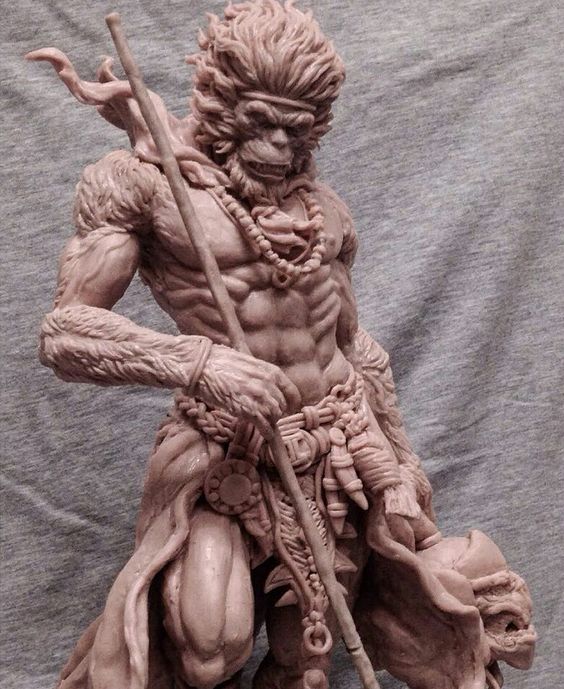
Sun Wukong possesses many abilities. He has amazing strength and is able to support the weight of two heaven mountains on his shoulders while running “with the speed of a meteor”.He is extremely fast, able to travel 108,000 li (54,000 km, 34,000 mi) in one somersault. Sun Wukong also acquires the 72 Earthly Transformations, which allow him to access 72 unique powers, including the ability to transform into sundry animals and objects. He is a skilled fighter, capable of defeating the best warriors of heaven. His hair has magical properties, capable of making copies of himself or transforming into various weapons, animals and other things. He also shows partial weather manipulation skills and can stop people in place with fixing magic.
The Unicorn’s Prophecy

This word might look like an attempt to cheat at Scrabble, but the Qilin is an ancient and amazing legend of China. It is an extraordinary creature with many powers, and looks nothing like the European unicorn which many of us will be familiar with, though it does share a few similar characteristics.
If you have an interest in Chinese mythology and history, the Qilin is a wonderful thing to explore. China is full of vivid and unusual mythological creatures. Many of them are well-known, such as dragons and phoenixes, but the Qilin is beautiful, interesting, and very deserving of attention.
It is one of the four noble animals of Eastern Asia, with the phoenix, dragon, and tortoise making up the other three. If you ever have an opportunity to visit China, you might be lucky enough to catch a glimpse of one in this beautiful country.
The Moon Goddess
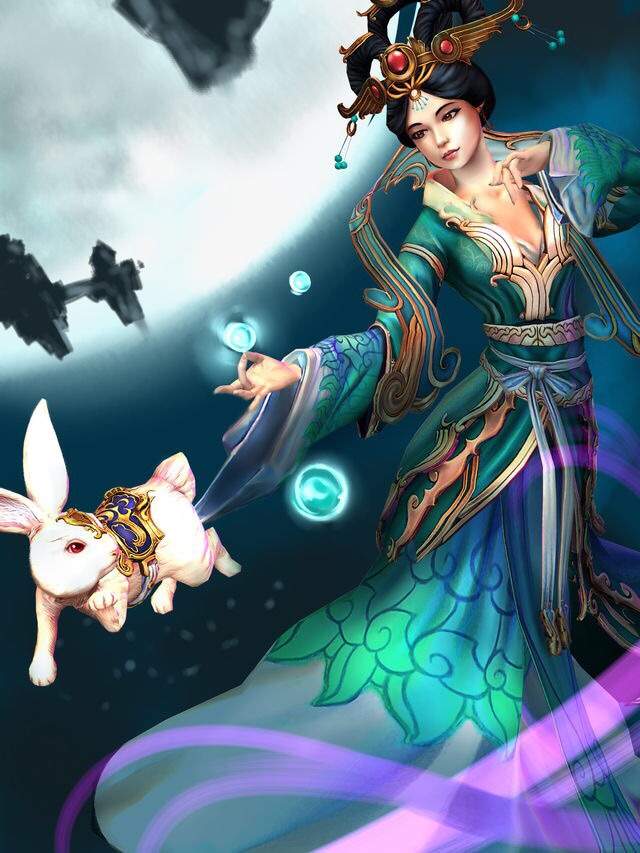
Chang’e, Wade-Giles romanization Ch’ang O, the Chinese moon goddess whose loveliness is celebrated in poems and novels. She sought refuge in the moon when her consort, Hou Yi (the Lord Archer), discovered she had stolen the drug of immortality given to him by the gods. Hou Yi’s pursuit was impeded by the Hare, who would not let the irate husband pass until he promised reconciliation.
Each year on the 15th day of the eighth lunar month, Chinese people celebrate the memory of Chang’e with a “Mid-Autumn Festival” (Zhongqiu Jie). With a full moon shining in the heavens, “moon cakes” are eaten and offered as gifts to friends and neighbours. Many go outside to view the supposed outline of a toad on the surface of the moon, for this creature, according to one legend, is now Chang’e. At one time she was called Hong’e, but the name became taboo when two Chinese emperors took it as their own.
A typical painting shows Chang’e floating toward the moon, often with her palace in the background. The Hare is sometimes present, preparing the drug of immortality. Statues more often represent her holding a moon disk in her raised right hand.
The Grand Archer Yi
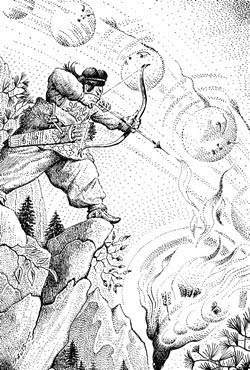
Hou Yi, Wade-Giles romanization Hou I, in Chinese mythology, the Lord Archer whose prowess with a bow earned him undying fame. With his bow and arrow he saved the moon during an eclipse and rescued the country from a variety of plagues, one of which involved a wind monster who was wreaking havoc across the land. Hou Yi is also said to have shot down 9 of 10 suns (one account says 8 of 9 suns) that were burning up the earth in prehistoric times. Though tradition identifies the marksman as an officer in the armed forces of the legendary emperor Ku, he is better known among the common people as the husband of Chang’e, the goddess of the moon. After stealing the pill of immortality, Chang’e took refuge in the moon. Hou Yi followed in hot pursuit, only to be intercepted by the Hare, who would not allow Hou Yi to pass until he promised reconciliation with his wife. On the 15th day of each lunar month the spouses meet, Hou Yi traveling from his palace in the sun to the moon palace he constructed for his wife.
Yu Rebuilds the Earth

Yu the Great (大禹) was a legendary king in ancient China who was famed for his introduction of flood control, his establishment of the Xia dynasty which inaugurated dynastic rule in China, and his upright moral character.He figures prominently in the Chinese legend of “Great Yu Who Controlled the Waters” (Chinese: 大禹治水; pinyin: Dà Yǔ Zhì Shuǐ).
The dates which have been proposed for Yu’s reign predate the oldest-known written records in China, the oracle bones of the late Shang dynasty, by nearly a millennium. Yu’s name was not inscribed on any artifacts which were produced during the proposed era in which he lived, nor was it inscribed on the later oracle bones; his name was first inscribed on vessels which date back to the Western Zhou period (c. 1045–771 BC).
The lack of substantial contemporary documentary evidence has caused some controversy over Yu’s historicity. Thus, proponents of his existence theorize that stories about his life and reign were orally transmitted in various areas of China until they were eventually recorded during the Zhou dynasty,while opponents of it believe that the figure existed in legend in a different form—as a god or a mythical beast—during the Xia dynasty, and morphed into a human figure by the start of the Zhou dynasty. Many of the stories about Yu were collected in Sima Qian’s famous Records of the Grand Historian. Yu and other “sage-kings” of Ancient China were lauded for their virtues and morals by Confucius and other Chinese teachers.
Yu is one of the few Chinese monarchs who is posthumously honored with the epithet “the Great”.
Water War
Gonggong (/ˈɡɒŋɡɒŋ/) is a Chinese water god who is depicted in Chinese mythology and folktales as having a copper human head with an iron forehead, red hair, and the body of a serpent, or sometimes the head and torso are human, with the tail of a serpent. He is destructive and is blamed for various cosmic catastrophes. In all accounts, Gonggong ends up being killed or sent into exile, usually after losing a struggle with another major deity such as the fire god Zhurong.
Gonggong is known from the late Warring States period (before 221 BC). Gonggong appears in the ancient “Heavenly Questions” (Tianwen) poem of the Chu Ci, where he is blamed for knocking the earth’s axis off center, causing it to tilt to the southeast and the sky to tilt to the northwest.This axial tilt is used to explain why the rivers of China generally flow to the southeast, especially the Yangzi River and the Yellow River, and why the sun, moon, and stars move towards the northwest. Literature from the Han dynasty becomes much more detailed regarding Gonggong.
Gonggong was credited in various mythological contexts as being responsible for great floods, often in concert with his minister Xiangliu (a.k.a. Xiangyao), who has nine heads and the body of a snake.
Gonggong was ashamed that he lost the fight with Zhurong, the Chinese god of fire, to claim the throne of Heaven. In a fit of rage he smashed his head against Buzhou Mountain, one of eight pillars holding up the sky, greatly damaging it and causing the sky to tilt towards the northwest and the earth to shift to the southeast, which caused great floods and suffering.
The goddess Nüwa cut off the legs of the giant turtle Ao and used them in place of the fallen pillar, ending the floods and suffering; she was, however, unable to fully correct the tilted sky and earth and alter their effects on the sun, moon, stars, and rivers in China.
Fushi Teaches the People
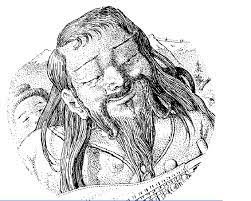
The most ancient myths involve the 10 legendary kings or gods who guided people through their prehistoric beginnings (around 3000 to 2197 BC). They were demigods (half god and half human), who lived among the people and taught them the rules of civilization. Fushi was the first ruler of this magical period. Many scholars believe that his story is based on an actual monarch who lived sometime between 2953 and 2736 BC. In all the many variations of these mythological stories, Fushi has been depicted as a beloved figure who taught survival skills to the early humans. He taught people how to use fire, how to cook, how to write, and many other skills like hunting, fishing, and fortune-telling. Some myths depict Fushi as having the body of a human while others depict him as having the head of a human and the body of a snake. In many stories, he is regarded as the husband of Nuwa and they are the creators of civilization.
Nuwa Creates People
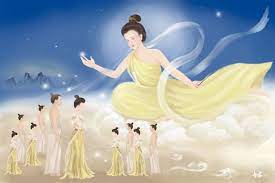
Nüwa, also read Nügua, is the mother goddess of Chinese mythology. She is credited with creating humanity and repairing the Pillar of Heaven.
As creator of mankind, she molded the upper-class individually by hand with yellow clay, and as she grew tired, she instead used a string to pull up the clay faster and form the lower-class.
In the Huainanzi, there is described a great battle between deities that broke the pillars supporting Heaven and caused great devastation. There was great flooding, and Heaven had collapsed. Nüwa was the one who patched the holes in Heaven with five colored stones, and she used the legs of a tortoise to mend the pillars.
There are many instances of her in literature across China which detail her in creation stories, and today remains a figure important to Chinese culture.
Panku (Pangu) Creates the World

Pangu (simplified Chinese: 盘古; traditional Chinese: 盤古; pinyin: Pángǔ; Wade–Giles: P’an-ku) is a primordial being and creation figure in Chinese mythology who separated heaven and earth and became geographic features such as mountains and rivers.
The first writer to record the myth of Pangu was Xu Zheng during the Three Kingdoms period. Recently his name was found in a tomb dated 156AD.
In the beginning, there was nothing and the universe was in a featureless, formless primordial state. This primordial state coalesced into a cosmic egg for about 18,000 years. Within it, the perfectly opposed principles of yin and yang became balanced and Pangu emerged (or woke up) from the egg. Pangu inside the cosmic egg symbolizes Taiji.Pangu is usually depicted as a primitive, hairy giant who has horns on his head. Pangu began creating the world: he separated yin from yang with a swing of his giant axe, creating the earth (murky yin) and the sky (clear yang). To keep them separated, Pangu stood between them and pushed up the sky. With each day, the sky grew ten feet (3 meters) higher, the earth ten feet thicker, and Pangu ten feet taller. This task took yet another 18,000 years. In some versions of the story, Pangu is aided in this task by the four most prominent beasts, namely the Turtle, the Qilin, the Phoenix, and the Dragon.
After the 18,000 years had elapsed, Pangu breathed. His breath became the wind, mist and clouds; his voice, thunder; his left eye, the Sun; his right eye, the Moon; his head, the mountains and extremes of the world; his blood, rivers; his muscles, fertile land; his facial hair, the stars and Milky Way; his fur, bushes and forests; his bones, valuable minerals; his bone marrow, precious jewels; his sweat, rain; and the fleas on his fur carried by the wind became animals.
Three main views describe the origin of the Pangu myth. The first is that the story is indigenous and was developed or transmitted through time to Xu Zheng. Senior Scholar Wei Juxian states that the Pangu story is derived from stories during the Western Zhou Dynasty. He cites the story of Zhong (重) and Li (黎) in the “Chuyu” section of the ancient classics Guoyu. In it, King Zhao of Chu asked Guanshefu (觀射父) a question: “What did the ancient classic “Zhou Shu” mean by the sentence that Zhong and Li caused the heaven and earth to disconnect from each other?” The “Zhou Shu” sentence he refers to is about an earlier person, Luu Xing, who converses with King Mu of Zhou. King Mu’s reign is much earlier and dates to about 1001 to 946 BC. In their conversation, they discuss a “disconnection” between heaven and earth.Derk Bodde linked the myth to the ancestral mythologies of the Miao people and Yao people in southern China.This is how Professor Qin Naichang, head of the Guangxi Institute for Nationality Studies, reconstructs the true creation myth preceding the myth of Pangu. Note that it is not actually a creation myth:A brother and his sister became the only survivors of the prehistoric Deluge by crouching in a gourd that floated on water. The two got married afterwards, and a mass of flesh in the shape of a whetstone was born. They chopped it and the pieces turned into large crowds of people, who began to reproduce again. The couple were named ‘Pan’ and ‘Gou’ in the Zhuang ethnic language, which stand for whetstone and gourd respectively.
The missionary and translator James Legge discusses Pangu:
P’an-ku is spoken of by the common people as “the first man, who opened up heaven and earth.” It has been said to me in “pidgin” English that “he is all the same your Adam”; and in Taoist picture books I have seen him as a shaggy, dwarfish, Hercules, developing from a bear rather than an ape, and wielding an immense hammer and chisel with which he is breaking the chaotic rocks.
Facts
- The Chinese prepared rice into wine.
- The earliest Chinese cooking method is broiling. Surprisingly, potato is used usually in Chinese dishes.
- In ancient times, chopsticks were called “Zhu”.
- During the ancient Chinese New Year, they ate dumplings at midnight.
- Chinese food has served to shape many Chinese myths, folklore, rituals, and religious observance.
- Unlike most places, the soup was always served after the main meal in ancient China.
- Most foods in ancient China were made in bite-sized pieces so that people could pick it apart.
- People suppose that ice cream originated in China in the 2,000- 3,000 B.C.
- Anise and ginger are spices native to China. Fortune cookies are not traditional Chinese food. Millet was a replacement for rice in Northern China.
You must be logged in to post a comment.